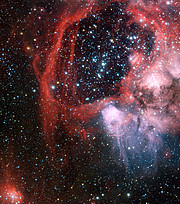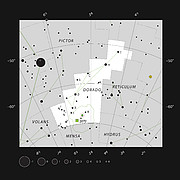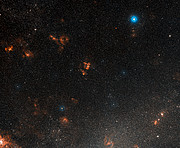Persbericht
Een kosmische superbubbel
20 juli 2011
Dit frappante beeld van de gasnevel rond de sterrenhoop NGC 1929 in de Grote Magelhaense Wolk, een buurstelsel van ons Melkwegstelsel, is vastgelegd met ESO’s Very Large Telescope. Deze stellaire kraamkamer wordt gedomineerd door een zogeheten superbubbel, ontstaan door de winden van heldere, jonge sterren en de schokgolven van supernova-explosies.
De Grote Magelhaense Wolk is een klein sterrenstelsel op relatief geringe afstand van de Melkweg. Hij bevat veel gebieden waar wolken van gas en stof bezig zijn nieuwe sterren te vormen. Een van die gebieden, gelegen rond de sterrenhoop NGC 1929, is in close-up te zien op deze nieuwe opname van ESO’s Very Large Telescope. De gasnevel heet officieel LHA 120-N 44 of kortweg N 44. Hete, jonge sterren in NGC 1929 stralen intens ultraviolet licht uit, wat het gas in de nevel aan het gloeien brengt. Door dit effect komt de toepasselijk ‘superbubbel’ genoemde, 325 bij 250 lichtjaar metende materieschil goed uit. (Ter vergelijking: de afstand tussen de zon en haar meest nabije buurster bedraagt slechts iets meer dan vier lichtjaar.)
De superbubbel in N 44 is ontstaan door een combinatie van twee processen. Eerst hebben sterrenwinden – stromen van geladen deeltjes van de zeer hete en zware sterren in de centrale sterrenhoop – het centrale gebied leeggeblazen. Vervolgens zijn er zware sterren in de sterrenhoop als supernovae geëxplodeerd, waardoor schokgolven ontstonden die het gas verder naar buiten drukten. Het resultaat is een kolossale ‘zeepbel’ van gloeiend gas.
Hoewel de superbubbel door verwoestende krachten is gevormd, worden in het samengedrukte gas aan de rand van de bubbel nieuwe sterren geboren. Deze nieuwe generatie van sterren, die dus het resultaat is van een kosmisch kringloopproces, zal NGC 1929 nieuw leven inblazen.
De foto is door ESO gemaakt op basis van gegevens die zijn opgespoord door Manu Mejias uit Argentinië [1], die in 2010 deelnam aan ESO’s astrofotografiewedstrijd Hidden Treasures [2]. Deze wedstrijd werd in oktober/november 2010 door ESO georganiseerd voor iedereen die het leuk vindt om mooie hemelopnamen te maken op basis van gegevens die met professionele telescopen zijn verkregen.
Noten
[1] Manu spoorde de ruwe gegevens voor zijn foto van NGC 1929 op in de ESO-archieven. Zijn oorspronkelijke inzending, die hier te zien is, eindigde op de zevende plaats.
[2] ESO’s fotowedstrijd Hidden Treasures 2010 stelde amateurastronomen in de gelegenheid om de enorme ESO-archieven door te spitten op onvermoede astronomische juweeltjes die alleen maar opgepoetst hoefden te worden. Meer informatie over Hidden Treasures is te vinden op http://www.eso.org/public/events/hiddentreasures/.
Meer informatie
ESO, de Europese Zuidelijke Sterrenwacht, is de belangrijkste intergouvernementele sterrenkundeorganisatie in Europa, en het meest productieve astronomische observatorium ter wereld. Zij wordt ondersteund door vijftien landen: België, Brazilië, Denemarken, Duitsland, Finland, Frankrijk, Italië, Nederland, Oostenrijk, Portugal, Spanje, Tsjechië, het Verenigd Koninkrijk, Zweden en Zwitserland. ESO voert een ambitieus programma uit, gericht op het ontwerp, de bouw en het beheer van krachtige grondobservatoria die astronomen in staat stellen om belangrijke wetenschappelijke ontdekkingen te doen. ESO speelt ook een leidende rol bij het bevorderen en organiseren van samenwerking op sterrenkundig gebied. ESO beheert drie waarnemingslocaties van wereldklasse in Chili: La Silla, Paranal en Chajnantor. Op Paranal staan ESO’s Very Large Telescope (VLT), de meest geavanceerde optische sterrenwacht ter wereld, en twee surveytelescopen: VISTA werkt in het infrarood en is de grootste surveytelescoop ter wereld en de VLT Survey Telescope is de grootste telescoop die uitsluitend is ontworpen om de hemel in zichtbaar licht in kaart te brengen. Ook is ESO de Europese partner van de revolutionaire telescoop ALMA, het grootste sterrenkundige project van dit moment. Daarnaast bereidt ESO momenteel de bouw voor van de Europese Extremely Large optische/nabij-infrarood Telescoop (E-ELT), een telescoop van de 40-meterklasse die ‘het grootste oog op de hemel’ ter wereld zal worden.
Links
Contact
Douglas Pierce-Price
ESO, Public Information Officer
Garching bei München, Germany
Tel: +49 89 3200 6759
E-mail: dpiercep@eso.org
Marieke Baan (Perscontact Nederland)
ESO Science Outreach Network
en NOVA Informatie Centrum
Tel: +31(0)20-5257480
E-mail: eson-netherlands@eso.org
Over dit bericht
| Persberichten nr.: | eso1125nl |
| Naam: | LHA 120-N 44 |
| Type: | Milky Way : Star : Grouping : Cluster Milky Way : Nebula |
| Facility: | Very Large Telescope |
| Instruments: | FORS1 |
Our use of Cookies
We use cookies that are essential for accessing our websites and using our services. We also use cookies to analyse, measure and improve our websites’ performance, to enable content sharing via social media and to display media content hosted on third-party platforms.
ESO Cookies Policy
The European Organisation for Astronomical Research in the Southern Hemisphere (ESO) is the pre-eminent intergovernmental science and technology organisation in astronomy. It carries out an ambitious programme focused on the design, construction and operation of powerful ground-based observing facilities for astronomy.
This Cookies Policy is intended to provide clarity by outlining the cookies used on the ESO public websites, their functions, the options you have for controlling them, and the ways you can contact us for additional details.
What are cookies?
Cookies are small pieces of data stored on your device by websites you visit. They serve various purposes, such as remembering login credentials and preferences and enhance your browsing experience.
Categories of cookies we use
Essential cookies (always active): These cookies are strictly necessary for the proper functioning of our website. Without these cookies, the website cannot operate correctly, and certain services, such as logging in or accessing secure areas, may not be available; because they are essential for the website’s operation, they cannot be disabled.
Functional Cookies: These cookies enhance your browsing experience by enabling additional features and personalization, such as remembering your preferences and settings. While not strictly necessary for the website to function, they improve usability and convenience; these cookies are only placed if you provide your consent.
Analytics cookies: These cookies collect information about how visitors interact with our website, such as which pages are visited most often and how users navigate the site. This data helps us improve website performance, optimize content, and enhance the user experience; these cookies are only placed if you provide your consent. We use the following analytics cookies.
Matomo Cookies:
This website uses Matomo (formerly Piwik), an open source software which enables the statistical analysis of website visits. Matomo uses cookies (text files) which are saved on your computer and which allow us to analyze how you use our website. The website user information generated by the cookies will only be saved on the servers of our IT Department. We use this information to analyze www.eso.org visits and to prepare reports on website activities. These data will not be disclosed to third parties.
On behalf of ESO, Matomo will use this information for the purpose of evaluating your use of the website, compiling reports on website activity and providing other services relating to website activity and internet usage.
Matomo cookies settings:
Additional Third-party cookies on ESO websites: some of our pages display content from external providers, e.g. YouTube.
Such third-party services are outside of ESO control and may, at any time, change their terms of service, use of cookies, etc.
YouTube: Some videos on the ESO website are embedded from ESO’s official YouTube channel. We have enabled YouTube’s privacy-enhanced mode, meaning that no cookies are set unless the user actively clicks on the video to play it. Additionally, in this mode, YouTube does not store any personally identifiable cookie data for embedded video playbacks. For more details, please refer to YouTube’s embedding videos information page.
Cookies can also be classified based on the following elements.
Regarding the domain, there are:
- First-party cookies, set by the website you are currently visiting. They are stored by the same domain that you are browsing and are used to enhance your experience on that site;
- Third-party cookies, set by a domain other than the one you are currently visiting.
As for their duration, cookies can be:
- Browser-session cookies, which are deleted when the user closes the browser;
- Stored cookies, which stay on the user's device for a predetermined period of time.
How to manage cookies
Cookie settings: You can modify your cookie choices for the ESO webpages at any time by clicking on the link Cookie settings at the bottom of any page.
In your browser: If you wish to delete cookies or instruct your browser to delete or block cookies by default, please visit the help pages of your browser:
Please be aware that if you delete or decline cookies, certain functionalities of our website may be not be available and your browsing experience may be affected.
You can set most browsers to prevent any cookies being placed on your device, but you may then have to manually adjust some preferences every time you visit a site/page. And some services and functionalities may not work properly at all (e.g. profile logging-in, shop check out).
Updates to the ESO Cookies Policy
The ESO Cookies Policy may be subject to future updates, which will be made available on this page.
Additional information
For any queries related to cookies, please contact: pdprATesoDOTorg.
As ESO public webpages are managed by our Department of Communication, your questions will be dealt with the support of the said Department.





